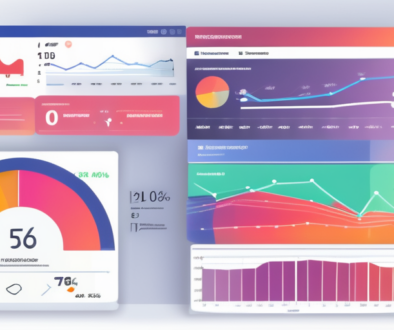Winning SEO Ad Metrics: What to Track for Best Results
The Value of SEO Ad Metrics in Driving Performance
In the world of digital marketing, data is a crucial element that can make or break a successful campaign. Understanding SEO ad metrics is essential for marketers, businesses, and entrepreneurs who wish to optimize their online presence. These metrics provide insights into how well your ads are performing and how they are contributing to your overall marketing strategy.
Tracking SEO ad metrics enables you to make informed decisions based on actual performance data. Rather than relying on assumptions, marketers can identify which aspects of their campaigns are successful and which require adjustments. This dynamic approach to advertising is vital in the ever-evolving landscape of the web.
Defining SEO Ad Metrics
SEO ad metrics refer to measurable values that help evaluate the effectiveness of online advertising campaigns. They encompass various indicators that reflect user engagement, spending efficiency, visibility, and conversion success.
Common metrics include Click-Through Rate (CTR), Cost Per Click (CPC), Quality Score, and Conversion Rate. By analyzing these metrics, marketers can assess their campaigns’ performance comprehensively and adapt strategies accordingly.
Why SEO Ad Metrics Matter
SEO ad metrics matter because they inform strategic decisions and resource allocation. Understanding how each metric interacts provides marketers with a roadmap to enhance their online advertising effectiveness. For instance, a high CTR may indicate that your ad is compelling, but if the conversion rate is low, adjustments may be needed in the landing page content or offer.
Moreover, tracking these metrics helps in understanding audience behavior and preferences. This knowledge allows businesses to refine their target demographics and improve overall campaign performance. By analyzing user interactions, marketers can uncover patterns that reveal the best times to engage their audience, the types of content that resonate most, and the channels through which they prefer to receive information. Such insights can lead to more tailored marketing strategies that not only attract clicks but also foster long-term customer relationships.
Additionally, the competitive landscape of digital marketing necessitates a keen focus on SEO ad metrics. As more businesses invest in online advertising, staying ahead requires a thorough understanding of how your ads stack up against competitors. Metrics like Share of Voice (SOV) can help determine your brand’s visibility in relation to others in your industry, while benchmarking against industry standards can highlight areas for improvement. This proactive approach ensures that your marketing efforts remain relevant and impactful in a crowded marketplace.
Key SEO Ad Metrics to Monitor
In your quest to optimize your advertising efforts, several key metrics emerge as pivotal indicators of success. These metrics not only guide your strategy but also enhance your understanding of your audience’s interactions with your content.
Click-Through Rate (CTR)
The Click-Through Rate (CTR) measures the percentage of users who click on your ad after viewing it. It is calculated by dividing the number of clicks by the number of impressions and multiplying by 100. A high CTR indicates that your ad is catching the audience’s attention and persuading them to engage.
Monitoring CTR helps identify which ads resonate with your audience. If a particular ad has a low CTR, it may require adjustments in the copy, design, or targeting strategy to enhance engagement. Additionally, experimenting with different ad formats, such as video or carousel ads, can also provide insights into what captures your audience’s interest more effectively.
Cost Per Click (CPC)
Cost Per Click (CPC) refers to the amount you pay for each click on your advertisement. This metric is crucial for understanding your advertising costs and budget efficiency. A lower CPC is generally more favorable, as it allows you to drive more traffic to your site without overspending.
Constantly reviewing your CPC can help identify which campaigns yield the best return on investment. It also aids in determining the balance between competitive bidding strategies and overall campaign costs. Moreover, analyzing the correlation between CPC and other metrics, such as conversion rates, can provide deeper insights into the effectiveness of your ad spend and help refine your bidding strategies over time.
Quality Score
Quality Score is a metric employed by search engines to assess the quality and relevance of your ads, keywords, and landing pages. It plays a central role in determining your ad position and CPC. A higher Quality Score typically results in lower costs and better ad placements.
Improving your Quality Score requires delivering a seamless and relevant user experience. Ensuring that your keywords align with your ad copy and landing page content is essential in this regard. Additionally, regularly updating your ads to reflect current trends and user interests can significantly enhance your Quality Score, as search engines favor fresh and relevant content that meets user needs.
Conversion Rate
The Conversion Rate measures the percentage of visitors who complete a desired action on your site, such as making a purchase or filling out a contact form. It is calculated by dividing the number of conversions by the total visitors and multiplying by 100. A high conversion rate indicates that your advertising efforts effectively drive meaningful actions.
By analyzing your conversion rates, you can gain insight into how well your landing pages are performing and whether they meet user expectations. This evaluation helps in modifying marketing messages or enhancing the User Experience (UX). Furthermore, segmenting your conversion data by demographics or traffic sources can uncover specific trends and preferences among different audience segments, allowing for more targeted and effective marketing strategies in the future.
Interpreting SEO Ad Metrics
Understanding and interpreting SEO ad metrics is not merely about recording numbers. It involves analyzing data trends and making data-driven decisions that improve your campaigns. The digital landscape is constantly evolving, and staying ahead requires a keen eye for detail and a willingness to adapt strategies based on the insights gleaned from these metrics.
How to Analyze CTR
To analyze CTR effectively, begin by monitoring the average CTR for your industry. This benchmark provides a context for your performance. Consider segmenting your data by ad group, keywords, and devices to identify patterns. Additionally, it’s crucial to assess the time of day and geographical locations where your ads perform best, as these factors can significantly influence CTR.
Pay attention to variations in CTR over time as well. It may reflect changes in audience preferences or the effectiveness of new content strategies. For instance, seasonal trends or current events can impact user engagement, making it essential to adjust your campaigns accordingly. Regularly updating your ad creatives and testing new calls-to-action can also help maintain a competitive edge and keep your audience engaged.
Understanding the Implications of CPC
Understanding CPC involves examining not only the costs associated with clicks but also how they affect your budget and overall return on investment. A high CPC could signal that your keywords are too competitive or that your ads lack relevance. Moreover, it’s important to analyze the lifetime value of customers acquired through these clicks, as a higher initial investment might be justified if it leads to substantial long-term gains.
Utilizing A/B testing can help you find cost-effective alternatives. Experimenting with different ad variations can lead to insights about what resonates best with your audience. Additionally, consider exploring long-tail keywords that may have lower CPCs but can still drive targeted traffic to your site, ultimately enhancing your overall campaign efficiency.
Deciphering Quality Score
Deciphering Quality Score requires a thorough understanding of its components: expected CTR, ad relevance, and landing page experience. Regularly checking Quality Scores across your campaigns allows you to identify areas for improvement. A higher Quality Score not only reduces your CPC but can also improve your ad placements, giving you a competitive advantage in crowded markets.
Improving Quality Score may involve refining keyword targeting, enhancing ad copy, or optimizing landing pages. A comprehensive review of these factors can lead to significant gains in performance. Additionally, incorporating user feedback and analytics can help you create more relevant content that aligns with user intent, further boosting your Quality Score and overall campaign effectiveness.
Evaluating Conversion Rate
Evaluating the conversion rate entails looking beyond numbers, seeking insights into user behavior. Employing tools like Google Analytics enables you to track actions taken on your site and identify possible drop-off points. By analyzing user pathways, you can pinpoint specific areas where users lose interest or encounter obstacles, allowing you to make informed adjustments to your site’s design or content.
Consider conducting user surveys or heatmap analyses to garner more qualitative feedback on why certain users may not convert. Understanding their journey can yield valuable insights for future optimization. Additionally, segmenting your audience based on demographics or behavior can help tailor your approach, ensuring that your messaging resonates with different user groups and ultimately drives higher conversion rates.
Utilizing SEO Ad Metrics for Strategy Improvement
The ultimate goal of tracking SEO ad metrics is to leverage insights for continuous strategy improvement. By using these metrics effectively, businesses can enhance their marketing efforts, maximize engagement, and ultimately achieve their goals.
Enhancing Your SEO Strategy with CTR
To enhance your SEO strategy with CTR insights, focus on creating more compelling ad copy that speaks directly to your audience’s needs. Testing different headlines, calls to action, and offers can significantly improve CTR.
Additionally, ensure that your ads are tailored to relevant demographics. Personalizing content can dramatically increase engagement, resulting in a higher CTR. For instance, utilizing data analytics tools to segment your audience based on behavior, interests, and demographics can help you craft messages that resonate on a deeper level. By understanding what drives your audience, you can create ads that not only attract clicks but also foster a sense of connection and relevance.
Using CPC to Optimize Ad Spend
Using CPC wisely can lead to optimized ad spending. Regularly revisiting your bidding strategy based on CPC performance enables you to allocate your budget effectively. Identify high-performing campaigns where a higher CPC can be justified by increased conversions.
Conversely, campaigns with a high CPC and poor conversions should be reevaluated or adjusted, ensuring your budget is directed toward the most effective ads. Consider implementing automated bidding strategies that leverage machine learning to optimize your bids in real-time, taking into account various factors such as time of day, device type, and user behavior. This can help ensure that you are getting the most value out of every dollar spent on advertising.
Improving Quality Score for Better Visibility
Improving Quality Score not only enhances ad position, but it can also lead to cost savings. Focus on enhancing ad relevance by closely aligning your keywords, ad copy, and landing pages. Ensuring a seamless user experience across all touchpoints is critical.
Remember that test and iteration are vital. Regularly review Performance Reports and User Feedback to identify opportunities for continued enhancements. Additionally, consider A/B testing different ad formats and placements to see which combinations yield the best results. This iterative approach allows you to refine your strategy continuously, ensuring that your ads remain competitive and effective in a constantly evolving digital landscape.
Boosting Conversion Rate for Increased ROI
Boosting the conversion rate is vital for increasing overall ROI. Employ strategies such as simplifying the user journey, employing clear calls to action, and utilizing remarketing tactics to encourage previous visitors to return.
Additionally, consider creating customized landing pages tailored to various audience segments. Tailored experiences can help resonate with users and significantly enhance conversion rates, providing a better return on your marketing efforts. Incorporating elements like social proof, testimonials, and trust signals can further enhance credibility and encourage users to take action. Furthermore, utilizing analytics to track user behavior on these landing pages can provide valuable insights into areas for improvement, allowing for ongoing optimization that aligns with user expectations and preferences.



